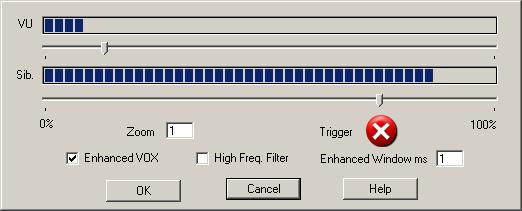

Displayed is a progress bar with the
current input signal strength (labeled VU) and a track bar to set the VU threshold,
another progress bar to indicate the sibilant signal strength (labeled Sib.) and
a track bar to set the threshold for that, a zoom setting and a trigger icon that
is only displayed when the signal strength is over the threshold. Additionally,
there is a check box to enable the enhanced VOX operation, a check box to enable
it's sibilant high frequency filter and an edit box to specify the duration (in
ms) of the sliding window that the enhanced VOX operates in. The display's maximum
value and the track bar's maximum value is 100% of the possible signal strength
(for the default non enhanced VOX this is 32767, a full scale 16 bit signal) unless
the Zoom is set to a value other than one in which case it is 100% / Zoom. It should
be noted that this zoom control is for the Digital VOX calibration dialog's display
purposes only, it in no way affects the signals that are processed. It's
possible you need to set the VU threshold when it's zoomed in as some
microphones would appear to be exceptionally quiet and then zoom out to set the
sibilant threshold.
By default the VOX operates as a simple single sample threshold
device subject to pops and lip smacks and so forth. When the enhanced check box
is checked the sibilant threshold and display are enabled and the VOX now operates
on as many samples as fill the number of milliseconds specified in the enhanced
window duration edit box. The sibilant display is a percentage of the samples in
the window that are on a peak in the waveform, effectively a measure of the high
frequency component of the signal, if the high frequency filter check box is checked
two samples will not be counted filtering frequencies around 11kHz. In enhanced
operation the VOX triggers if either VU or the sibilant signals exceed their threshold.
The window that the enhanced VOX operates on is a sliding window,
meaning that accuracy of RT measurement is unaffected by the duration of the window
(other then by increasing the effective nature of it's triggering).
The thresholds and mode of
operation (enhanced or un-enhanced) are stored in the registry for future runs of
DMDX unless the cancel button is pressed.
If the message "WARNING: No Data Received" appears then it is
unlikely that the audio card in your machine is capable of the full duplex operation
required for use with DMDX. The only other thing possible is that the sound card
is somehow improperly configured.
If you are having trouble with
the sensitivity of the VOX we have a report of third party software being able
to tweak the audio so DMDX can trigger reliably on it. It's
DFX Audio Enhancer.
DMDX Index.